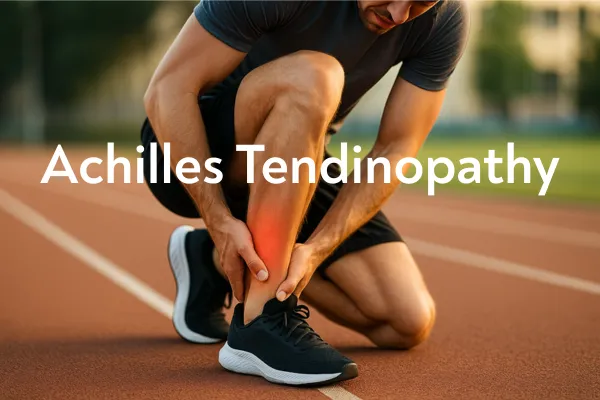Read our Blog

Achilles Tendinopathy: What You Need to Know
When Achilles Tendinopathy Becomes an Achilles Tear: What You Need to Know
Introduction
Achilles tendinopathy is very common, especially among active people, runners, or those who push their heels hard. It causes pain, stiffness, and can limit your activity. What many don’t realize is that, left unmanaged or under-rehabilitated, tendinopathy increases the risk of a partial or complete Achilles tendon tear (rupture). Understanding why it happens and what you can do to stop it is essential—because the consequences of a tear are serious and recovery takes longer.
In this post, we’ll cover:
Evidence showing how often Achilles tendinopathy eventually progresses to a tear
The most common injury mechanisms & contributing risk factors
How to treat Achilles tendinopathy well to reduce risk of tear
What realistic prevention and rehab look like
How Common Is Rupture if You Already Have Tendinopathy?
Some research gives numbers so you can understand risk in real terms:
A study titled “The Risk of Achilles Tendon Rupture in Patients with Achilles Tendinopathy” found that around 4% of patients with diagnosed Achilles tendinopathy go on to suffer a full rupture. PMC
People aged 50-59 had among the highest risk (~4.3%) in that study. PMC
Achilles tendinopathy in athletes is common. Lifetime incidence in athletes is approximately 24%. NCBI
Among recreational runners, the incidence of new Achilles tendinopathy (which precedes risk) is about 4.2% annually. ScienceDirect
So while not everyone with tendinopathy will tear, the risk is far from trivial—especially if certain risk factors exist and management is poor.
How Does an Achilles Tendon Tear Happen?
To prevent tears, first we need to understand how they tend to occur. There are usually two components: long-standing tissue changes from tendinopathy + a sudden overload or mechanical event.
Common Mechanisms of Injury
Sudden, forceful push‐offs or plantar flexion when the foot is dorsiflexed (toes upward, heel down) while the calf muscles are loaded. This can happen in sprint starts, jumping, or changing direction quickly.
Unexpected dorsiflexion when the tendon is already under tension. For example, stumbling off a step, or landing awkwardly.
Weekend warrior effect: individuals who are inactive most of the week, then suddenly engage in high-intensity activity. Their tendon may be less ready to tolerate load.
What’s Going On Under the Surface (Tendinopathy Changes)
People with tendinopathy often have:
Disorganized collagen fibers (less type I, more type III), which are weaker. NCBI
Areas of reduced blood supply (especially 2-6 cm above the insertion to the heel), which heal more slowly. NCBI+1
Ongoing microdamage from overuse, failed repair signals, inflammation or degeneration. NCBI
These structural changes make the tendon more vulnerable. When a sudden load or poor movement happens, it may tear.
Risk Factors That Increase Tear Rates
Certain factors make this rupture risk higher in someone with Achilles tendinopathy:
Risk Factor
Why It Contributes
Age (especially 50-60s)
Healing slows, collagen loses quality, less tissue elasticity. PMC+1
Previous tendinopathy history
Prior tendon degeneration is a clear risk for rupture. PMC+1
High body mass index / obesity
More load through the tendon at rest and during movement. NCBI+1
Sudden increases in load / abrupt training changes
Increase in jumping volume, running distance, or speed too fast without ramping up tolerance causes overload beyond threshold. British Journal of Sports Medicine+1
Poor muscle strength / imbalance (calf/gastrocnemius-soleus weakness)
The muscle isn’t able to absorb force well, so more goes through tendon. NCBI
Medications or health conditions
Fluoroquinolones, corticosteroids, metabolic disorders, diabetes may impair tendon structure. NCBI+1
Poor biomechanics (foot arch anomalies, ankle motion limitations, poor training surfaces)
These increase load or change direction in ways that strain vulnerable zones. NCBI+1
Treatment & Prevention: How to Stop Tendinopathy Turning Into a Tear
The good news: with early and appropriate management, many cases of Achilles tendinopathy can improve significantly, and rupture risk can be reduced.
Evidence-Based Treatment Strategies
Loading Programs / Progressive Strengthening
Heavy slow resistance (HSR) training: controlled calf raise exercises (straight knee and bent knee) at moderate to high load, slow tempo. This improves tendon stiffness and strength.
Eccentric loading: lowering down slowly on a raised surface (like heel drops). Often used in protocols for non-insertional Achilles tendinopathy.
Isometrics
Holding calf raises in a mid-point position under load, static hold (e.g. 30-45 seconds) can help reduce pain and improve force output, making movement more tolerable early on.
In early stages when the tendon is highly irritable, research suggests to accumulate 225 second of heavy isometric holds for optimal outcomes. This can be done in a variety of ways (ie. 5 sets of 45 seconds, 4 sets of 60 seconds, etc.)
Plyometrics and Elastic Work
As tendon symptoms improve and strength returns, adding plyometric work (jumping, hopping, bounding) helps restore the tendon’s capacity to store and release energy. This is important so the tendon can handle dynamic loads and reduce risk of tear.
Load Management & Gradual Progression
Avoid sudden spikes in training volume, intensity, or changes in surface. Gradually increase load. Use cross-training or rest phases.
Modify or avoid specific activities that irritate the tendon when symptoms flare. Complete rest is not recommended.
Address Contributing Factors
Improve calf strength and flexibility (for the gastrocnemius and soleus muscles).
Correct movement mechanics: foot alignment, ankle range of motion, landing mechanics, etc.
Use proper footwear, avoid very hard or uneven surfaces
Engage in appropriate warm-ups prior to activity.
Manage systemic health: weight control, treat metabolic disorders, avoid risky meds if possible.
Monitoring & Early Intervention
Recognize warning signs: persistent pain, stiffness, thickening, or crepitus in tendon.
Use imaging or ultrasound if needed to detect degeneration early.
What The Research Says About Tear Rates & Prevention
In the study by Yasui et al., about 4.0% of people with Achilles tendinopathy developed a full rupture. PMC
Age 50-59 had a bit higher risk in that group. PMC
Risk factors like obesity, medication use, and abrupt load increases are shown in StatPearls and other reviews. NCBI+1
Why Tendon Tears Heal Worse than Tendinopathy & What a Tear Means
When a rupture happens:
The tendon is fully or partially torn, which often requires much longer recovery (often surgery or advanced rehab), and sometimes there’s permanent loss of strength, elasticity, or function if not treated well. NCBI+1
Rerupture risk depends on treatment method and rehab: nonoperative treatment has higher re-rupture risk than surgical repair, though recent evidence suggests that with proper functional rehab, nonoperative outcomes can be close. Medscape+1
Key Takeaways: What You Can Do Now
Act Fast. Don’t ignore mild Achilles pain—microdamage accumulates.
Start a guided loading program. Under supervision, begin heavy slow resistance & eccentric work.
Don’t skip the plyometric work. Helps restore tendon elasticity.
Manage your risk factors. Weight, mechanics, footwear, medications.
Consistency over intensity. Better to do moderate work consistently than spike hard and hurt.
Seek professional guidance. Physical therapists can tailor programs, correct form, monitor progress.
Conclusion
Achilles tendinopathy is more than just a painful annoyance. It’s a structural change in your tendon that increases risk for rupture. While the tear rate isn’t extremely high, for certain people with risk factors it is meaningful. But with early detection, progressive rehab, and careful return to activity including both strength and plyometrics, you can significantly lower the risk and relieve symptoms altogether.
If you’re living with Achilles tendon pain, don’t wait for it to get worse. At Revive Physiotherapy, we can help you build a plan to reduce pain, restore strength, protect your tendon, and keep you active for the long term.
If you’ve had Achilles tendon pain for more than a few weeks or are worried about rupture, let’s talk. Call us today to schedule an assessment or book online to begin a tailored rehabilitation plan designed to protect and strengthen your tendon.
Keep moving smart — protect your Achilles!
Our one-on-one treatment sessions ensure that you fully understand your body and take ownership of your health so that you can have control over doing the things you love!
Send us a Message
Let's Have a Chat
954 - 519 - 4185
Find us at
2852 E Oakland Park Blvd
Fort Lauderdale, FL 33306
2024 REVIVE PHYSIOTHERAPY | ALL RIGHTS RESERVED


